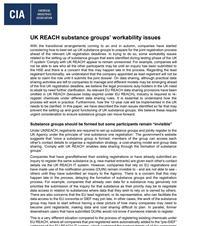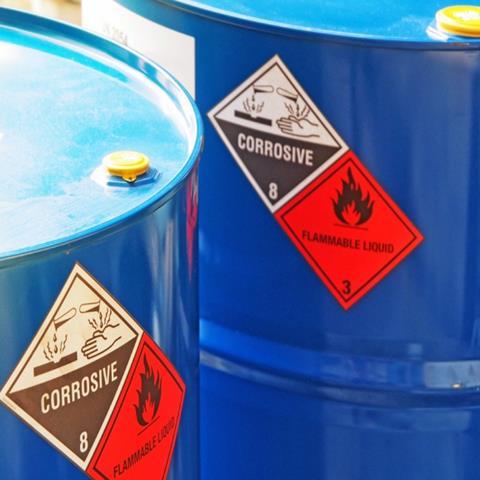In trying to do so, some workability issues related to the setting up of substance groups that were identified during testing phase of the UK IT system ‘Comply with UK REACH’ appear to remain unresolved. For example, companies will not be able to see who all the other participants may be until an inquiry has been submitted to the HSE and there is a concern that this may happen late in the process. Regarding the lead registrant functionality, we understand that the company appointed as lead registrant will not be able to claim the role until it submits the joint dossier. On data sharing, although practical data sharing activities are left to companies to manage and different models may be emerging ahead of the first UK registration deadline, we believe the legal provisions duty-holders in the UK need to abide by need further clarification. As relevant EU REACH data sharing provisions have been omitted in UK REACH (because today expired under EU REACH), industry is required to re register chemicals under different data sharing rules. It is essential to understand how the process will work in practice. Furthermore, how the 12-year rule will be implemented in the UK needs to be clarified. In this paper, we have described the main issues identified so far that may prevent the setting up and good functioning of UK substance groups. We believe these require urgent consideration to ensure substance groups can move forward.
Substance groups should be formed but some participants remain “invisible”
Under UKREACH, registrants are required to set up substance groups and jointly register to the UK Agency under the principle of ‘one substance one registration’. The government’s website suggests that “once a substance group is formed, members of the group can access each other’s contact details to organise a registration strategy, a cost-sharing model and group data sharing. ‘Comply with UK REACH’ enables data sharing through the formation of substance groups”.
Companies that have grandfathered their existing registrations or have already submitted an inquiry to register the same substance (e.g. new market entrants) are given each other’s contact details via the UK REACH IT system. However, companies that rely on EU registrations and have made use of the notification process (DUIN) remain invisible to - and are not able to see - others until they have submitted an inquiry to the Agency. There is a concern that this may happen late in the process, delaying the formation of substance groups and the registration process. For example, companies that already own data for a substance may genuinely not prioritise the submission of the inquiry for that substance as their priority may be to negotiate data access in relation to substances where data that they wish to rely on is owned by others. There are also concerns that the EU lead registrant, or its representative, who can facilitate the data access to the EU consortia or SIEF may join late. In other cases, the work of the substance group may have to start without having a clear picture of how many companies may need to become joint registrants, making data and cost sharing difficult to plan. In parallel, former downstream users that have submitted DUINs would not know if someone intends to register.
This is a very different situation compared to the process of registering existing chemicals under EU REACH, where all companies that pre-registered were automatically added to the “pre-SIEF” webpage of the EU REACH IT system, which contained the contact details of all the companies that pre-registered the same substance. After agreeing that companies had the same substance, the substance group was formed. Active companies were strongly encouraged to check the level of involvement of the other participants; cost sharing policies had then to be developed and communicated to all members of the substance group, including those that were not active at that time. In UK REACH, this is simply not possible because companies will not have a clear sight of who the other registrants may be.
UK substance groups cannot be set up in an efficient way if they are made only of companies that have grandfathered or submitted an inquiry. Further consideration should be given to allow for the transfer of DUIN data to the UK-REACH-IT system or provide the substance group with the contact details of the companies that have notified. Alternatively, early submission of inquiries should be encouraged or a deadline to make an inquiry, possibly with less onerous requirements on analytical chemistry, could be set to establish a genuine intention to register for those companies submitting notifications. We understand that one concern around adding the DUINs to the substance group would the clogging of the system with unnecessary/unclear substances. In this case, a compromise could be that those DUIN submissions that quote a registration number are added as their identity has already been reasonably clarified.
In addition, the dissemination database of registration dossiers should be published as soon as possible to allow companies, including downstream users, to see who has registered in those cases where the identity of the registrant is not claimed confidential. This may help some companies in determining whether they should be ultimately register.
On a separate matter, companies are reporting that in some cases there are multiple substance groups for the same substance, but there is currently no way to see what other groups there are. That means it is difficult to make an informed decision on whether there is need to move to the other group, and there’s no current mechanism for moving between groups. The separate groups emerged depending on exactly how the substance was described in the grandfathered dossier and in the EU registration, and which CAS/EINECS was used for each. In EU REACH, there was the option to include read-across substances which allowed sight of other SIEFs, but at present there is no option for this in UK. Companies would appreciate if the issue can be addressed in a future update of the IT system.
The lead registrant should be visible in UK REACH IT early on
Under UKREACH, a lead registrant needs to be appointed by the substance group to submit the joint registration dossier for that substance on behalf of all group members. It is suggested that the lead registrant role should be claimed on ‘Comply with UK REACH’ once the dossier is ready to be submitted, with the IT system only allowing a company to become lead registrant if it submits an updated dossier. A lead registrant needs to coordinate the management of the substance group’s operational rules and the joint lead dossier, so the dossier will be available after the appointment as lead. Once appointed, the lead registrant should be visible in UK REACH-IT to facilitate contact with other participants that may join later. If the lead identifies himself only when the dossier is ready, there are also several risks such as potential duplication of efforts as several companies may try to work with the EU substance groups/consortia or no one may be taking the lead as expecting someone else to do it. While we appreciate the IT system may have been designed to try to prevent cases of companies falsely claiming to be lead registrants, we believe this issue needs further consideration.
Clarity is needed on data sharing obligations for substance group members
The EU registration process of existing chemicals was based on the formation of SIEFs (Article 29) and on the specific mechanisms to share information set by Article 30. These articles have been omitted in UK REACH as the phased registration process was already completed in the EU. However, a separate registration process is now established in the UK. We would appreciate clarity on which mechanisms the sharing of data among UK participants is now expected to work, including in relation to potential disputes. While we would assume data sharing will be based on the provisions set by Article 27, which are maintained in UK REACH, we note that these refer to data sharing where substances have been registered. This happened in EU but, in most cases, not yet (or not in full) in the UK.
Example. A GB company wishes to start manufacturing a substance at >100 tonnes per year. There is a non-GB data-holding company that may register in 2027 and it may share data late in the process. How can the GB company proceed with its registration? UK REACH doesn’t appear to contain a provision that would legally require a data owner to share relevant data with other participants before the substance is registered. In addition, the data owner will not be visible in the substance group until an inquiry is submitted.
Data sharing is expected to be more complex than in EU REACH given that some companies may be previous EU registrants with various levels of data access and other companies have no previous access as they were UK downstream users.
Example. Previous registrants could extend data access from the EU LR for the purposes of submitting their own registration in UK, whereas previous UK downstream users (DUs) would have to ask for it for the first time, although this would not be obligatory. Would the data sharing process in the UK substance group need to follow Article 27? DUs may or may not approach EU data while previous registrants who may extend data access may be able to submit a registration but not necessarily be able to share data with co-registrants who were previous DUs.
Clarity is needed on the application of the 12-year rule in the UK
UK REACH foresees that the 12-year rule period starts from when any study summary or robust study summary was submitted either to HSE or to ECHA under EU REACH. It has been confirmed that the “clock does not start again 1 January 2021, so if the information was provided in a registration to ECHA in 2010, the 12-year period comes round in 2022”. While the provision may apparently reduce some of the significant costs associated with data access, discussions around it appear to be challenging. Companies are reporting that the proposed approach to the UK 12-year rule may act as a disincentive to companies acting as potential UK lead registrants given that the first UK registrant could pay for data from the data holder and then other UK registrants can access for free. Alternatively, a data holder may choose not to share if he knows that on submission of the data the UK authorities will allow free access to all UK companies. Our understanding is that study summaries used in the EU cannot just be used by companies in other jurisdictions without the permission of the data owner. Would the UK Agency accept a waiver for a study summary that it is older than 12 years instead of the study summary indicating that 12 years have passed?
While the intention of Art 25.3 is clear, how the provision would be implemented in practical terms is not and it needs further consideration. For example, for substances that were already registered under EU REACH but not grandfathered in the UK - where UK substance groups may be only made of companies that will have notified/submitted Article 26 Inquiry (e.g. GB only representatives, GB importers/former EU downstream users or new market entrants) - will a new 12 year period instead be applied at the point of the submission of the UK lead registrant dossier as these would be ‘new UK registrations’? UK REACH Article 26.3 appears to imply that the 12- year period would carry over only in those cases where the UK registration came into existence under the UK grandfathering process. What would also happen in the case of substance groups where UK companies that have grandfathered will not be lead registrants, i.e. their dossiers will not contain the study summaries and robust studies summaries? Companies need urgent clarity on these practical scenarios to support their negotiations on data access and sharing.
Under EU REACH, robust studies summaries are to be made available for the purpose of EU REACH registration 12 years from the data each of them is submitted to ECHA. In UK REACH, while UK grandfathered registrations had to include the registration date assigned to the previous EU registration by ECHA, that date may not necessarily correspond to the data of first submission of a given summary in the EU. New or updated information could have also been submitted later in the EU as part of an update of the dossier. There may also situations where the summary is used in various dossiers (e.g. read-across). In this case, is it the date of submission of the robust studies summaries in the first dossier that counts? Practical guidance to determine when data are older than 12 years under UKREACH and how the Agency intends to implement the process would be helpful.

UK REACH substance groups’ workability issues
With the transitional arrangements coming to an end in autumn, companies have started considering how to best set up UK substance groups to prepare for the joint registration process ahead of the relevant UK registration deadlines.
DOWNLOADPDF | 166 Kb























